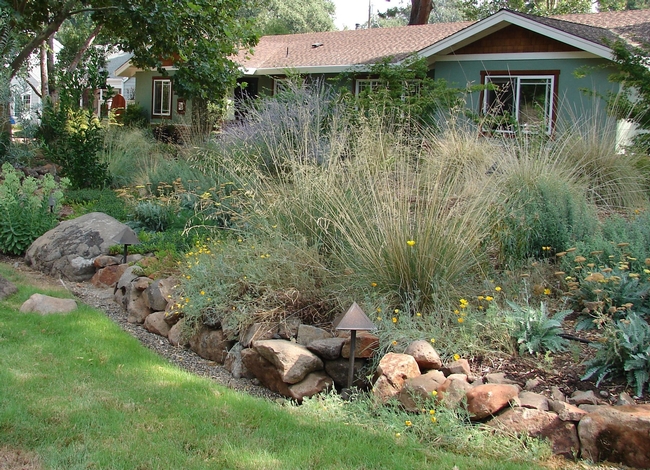By Eve Werner, Butte County Master Gardener, February 21, 2014

Lawns make an unbeatable playing surface. But many lawn areas, especially those in front yards, are rarely tread upon. Too often, they are grown by default for their reliable greenery. Keeping them lush and healthy expends resources in addition to water. Pesticides, fertilizers, and herbicides sometimes when applied to lawns can pose health risks to humans and leach into waterways. Gas-powered lawn mowers produce as much as 5% of the nation's air pollution each year. Native gardens, in contrast, provide beauty that is truly “green”.
The following three steps can guide you in successfully converting your lawn into a native garden.
First, observe. What existing trees and plants do you want to keep or remove? What are the sun and shade patterns? What types of grass grow in your lawn?
Next, kill your lawn. Homeowners can use either of two eco-friendly methods to kill their lawns. Solarizing involves heating the soil by covering it with a clear plastic tarp for four to six weeks during summer. It works best on fescue, ryegrass, and bluegrass, and with limited success on Bermuda grass. Sheet mulching is a method of layering materials (one of which is often cardboard) in order to inhibit the growth of weeds or (in this case) turf grass. Sheet mulching can be started any time of the year, takes six to eight months, works in sun or shade, and is effective on all grasses, including Bermuda grass. The UC Statewide Integrated Pest Management program website, http://www.ipm.ucdavis.edu, has information and instructions for both methods.
Finally, replant. Whichever method you choose, time implementation so that you are ready to replant in the fall. The cool temperatures and moist soils of October, November, and December allow native plants to develop the healthy roots they need to thrive with little water during the heat of summer.
Select a mix of trees, grasses, perennials, and shrubs for your native garden. Trees such as Western Redbud and Desert Willow add shade, privacy, and colorful blossoms. Dramatic bunch grasses like Deer Grass, California Fescue, and Blue Gramma grass enliven with texture and movement. The flowering evergreen shrubs Ceanothus ‘Concha,' Cleveland Sage, and California Buckwheat provide definition and screening. Perennials such as yarrow, BOP Penstemon, Naked Buckwheat, and California Fuchsia bring pizazz and pollinators into the garden. Sticky Monkey-flower and Hummingbird Sage brighten part-shade areas beneath existing trees. And, for those who miss the year-round green of their former lawn, there are evergreen groundcover manzanitas such as ‘Emerald Carpet' and ‘Green Supreme.'
It's a beneficial equation! A native garden can add a great deal to your garden while subtracting a chunk from your water bill.
On Monday, March 10, the Butte County Master Gardeners will present a workshop on this topic at the Chico Library, located at the corner of First and Sherman Avenues, from 10 to 11 am. The workshop, “Replacing Your Lawn,” will present techniques for lawn removal; it is one of a series of workshops the Master Gardeners will present on Mondays in March to help home gardeners deal with the present drought situation.
Sources:
http://saveourh2o.org/content/outdoors
http://www.ipm.ucdavis.edu/mitigation/